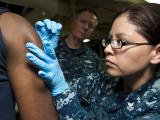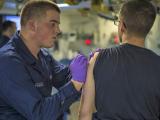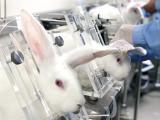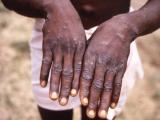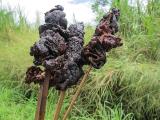Oct 14, 2004 (CIDRAP News) Federal researchers report they have succeeded in infecting monkeys with fatal smallpox, creating the first animal model of the disease for use in testing vaccines and treatments for humans.
Researchers exposed cynomolgus macaques to high doses of variola (smallpox) virus, causing most of them to die of the hemorrhagic form of smallpox within a few days, according to an online report in the Proceedings of the National Academy of Sciences (PNAS). Scientists previously thought that humans were the only species susceptible to smallpox.
"The demonstration that variola virus strains can produce lethal disease in monkeys is a significant advance toward the development of antiviral drugs and improved vaccines, as well as an improved understanding of variola pathogenesis," says the report by Peter B. Jahrling of the US Army Medical Research Institute of Infectious Diseases (USAMRIID) and colleagues from USAMRIID, the Centers for Disease Control and Prevention, and Stanford University.
Under the Food and Drug Administration's (FDA's) "animal efficacy rule," treatments and vaccines can be approved on the basis of animal data alone if human trials are impractical or unethical, as in the case of smallpox. The FDA rule requires that the actual pathogen be used and that "the disease process be faithful to the human disease," the report notes.
The success of Jahrling and his team in inducing lethal smallpox in monkeys has been no secret, having been described in Richard Preston's 2002 book The Demon in the Freezer. But the current PNAS report is apparently the first full description of the research in a journal.
The team previously reported exposing two groups of monkeys to a variola virus aerosol, which caused infection but not serious illness. In the present experiment, the researchers used two other variola strains (Harper and India 7124). Groups of monkeys received either an intravenous injection of virus accompanied by aerosol exposure or an IV injection alone.
Nineteen of 21 monkeys that received the highest doses of virus died, most of them within 6 days after exposure. Of 12 monkeys that received a lower dose, only one died. Both strains of virus were lethal to most of the monkeys at the highest doses, and the infections were mostly fatal regardless of whether exposure was by injection and aerosol or by injection alone.
"The i.v. inoculation of high doses of variola virus produced an overwhelming, hemorrhagic disease course, ending in acute deaths, usually within 6 days of inoculation," the report states. Postmortem examination showed high levels of virus and widespread hemorrhages in the monkeys' organs.
The use of IV inoculation of the virus eliminated the incubation and prodromal stages of natural smallpox, causing "instantaneous viremia" and resulting in a much shorter clinical course than was typical when smallpox still existed in humans, the authors note. "Yet, the sequence of events in the monkeys is similar to human hemorrhagic smallpox, a form that was almost always fatal." In humans, only about 2% to 3% of smallpox cases were hemorrhagic.
The authors say that the ideal animal model of smallpox would more closely resemble ordinary smallpox in humans, with a longer clinical course and without hemorrhagic manifestations, but would still cause high mortality. They tried to achieve this by giving monkeys lower doses of virus, which resulted in both reduced hemorrhage and lower mortality.
The article says that variola and monkeypox viruses cause very similar diseases in monkeys. Accordingly, the authors hope to test most smallpox countermeasures in the monkeypox model. "The variola primate model would be reserved for testing only those countermeasures that have passed all other FDA requirements for drug or vaccine licensure," they state.
Analysis of tissue from the infected monkeys has already yielded some information about how smallpox changes gene activity in cells attacked by the virus, yielding clues about how it overcomes host defenses, according to a separate report in PNAS.
David Relman, MD, of Stanford University, and colleagues analyzed how the smallpox infection altered gene expression in the monkeys' blood cells, according to a news release from the National Institute of Allergy and Infectious Diseases (NIAID), which supported the research. The researchers used DNA microarrays, a fairly new tool, to examine changes in levels of gene expression and expression of some proteins in the blood of infected monkeys.
"This new research fills in some of the gaps in our understanding of smallpox," NIAID Director Dr. Anthony Fauci, MD, said in the news release. "Now we are better positioned to speed the development of protective measures."
Jahrling PB, Hensley LE, Martinez MJ, et al. Exploring the potential of variola virus infection of cynomolgus macaques as a model for human smallpox. Proc Nat Acad Sci 2004 Oct 11 (published online before print) (Full text)
Rubins KH, Hensley LE, Jahrling PB, et al. The host response to smallpox: analysis of the gene expression program in peripheral blood cells in a nonhman primate model. Proc Nat Acad Sci 2004 Oct 11 (published online before print) (Full text)

